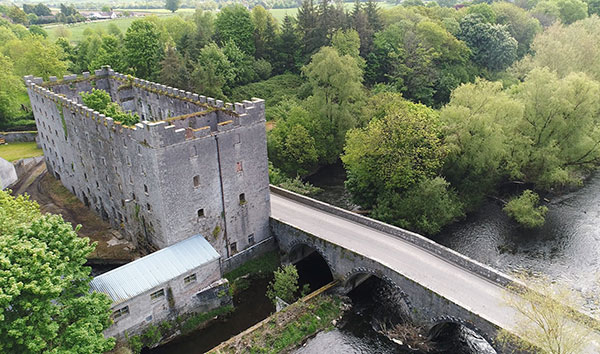GEMS OF ARCHITECTURE: Strongstream mill
Published in Gems of Architecture, Issue 4 (July/August 2019), Volume 27Milford, Co. Carlow
By Shay Kinsella
Beloved of wedding photographers and visual artists today, Strongstream mill is a striking physical monument to the ‘golden age’ of Irish milling in the late eighteenth century, which had its genesis in the Inland Bounty Act of 1758. To ensure an adequate supply of corn and flour to the capital, this legislation offered premiums to enterprising millers in the provinces and effectively made Carlow the ‘granary of Dublin’, according to one commentator.
Completed in 1789 at Ballygowan, four miles south of the county town, by Captain Richard Mercer, Strongstream was remarkable in its power (grinding 15,000 barrels of oats annually) and its height of seven storeys, but it did not come to enjoy national fame until it was subsumed into the milling empire of John Alexander (1764–1843). A Belfast native who was attracted south by such favourable economic conditions, Alexander rechristened the area ‘Milford’ and purchased Strongstream in 1807. He then masterminded a series of structural and mechanical improvements here and in his gargantuan flour mill and malthouse slightly downstream that made the combined enterprise ‘the most extensive and celebrated in Ireland’ in 1840, according to Mr and Mrs Samuel Carter Hall.
As the sole surviving specimen of this ‘perfect colony of flour mills’, Strongstream offers many indications of the quality of the Milford works. Alexander expanded on the original frame, extending eastwards and westwards to create an 11-bay x 2-bay building, 107ft long. Built from coursed rubble stone, its perfectly plumb walls were complimented in a recent survey (2007). One of the most significant aspects of the improvements at this time was the consideration of architectural aesthetics. Determined to make his behemoths as easy on the eye as his brand name ‘Milford’ was on the ear, Alexander ornamented the corners of the building with flat granite coigns and its windows with segmental brick openings and granite ledges. It was at the summit of Strongstream’s walls, however, that one observed Milford’s defining architectural feature. Above the flat roof, a crenellated parapet formed a castellated skyline of battlements, making a dramatic and romantic contribution to the skyline, which led a reporter from the Irish Times to describe Milford in 1862 as ‘more a paradise than a place of business’. Alexander pioneered the notable fashion for castellated mills in the Barrow Valley and can be credited as an early champion of moves to enhance the architectural merit of industrial buildings, pre-empting Sir William Fairbairn’s campaign in Britain from 1827 onwards.
With an annual turnover in excess of £45,000, Strongstream’s most influential customer was Prince Albert, who purchased almost 60 tonnes of its highly prized oatmeal for the royal household in 1856–62. Milling had ceased there by 1891, when J.E.H. Gordon, an ambitious London engineer, leased its waterwheel to power a hydroelectric turbine. He thus enabled a glorious and historic reinvention for the mill when Carlow became the first inland town in the United Kingdom to be lit by electricity, generated in Strongstream.

Above: Strongstream mill—above the flat roof, a crenellated parapet formed a castellated skyline of battlements.
The building also housed the headquarters of the short-lived Milford Cooperative Dairying Society (1891–1901), where Sir Horace Plunkett lectured on the cooperative project to local farmers twice in 1891. Strongstream’s wartime incarnation as a sawmill had ceased operations by 1945. Forty years later, John Alexander V (1927–2017) installed a modern hydropower turbine that still supplies electricity to the national grid.
Shay Kinsella completed a Ph.D on the Alexander works at Milford in 2015.
















